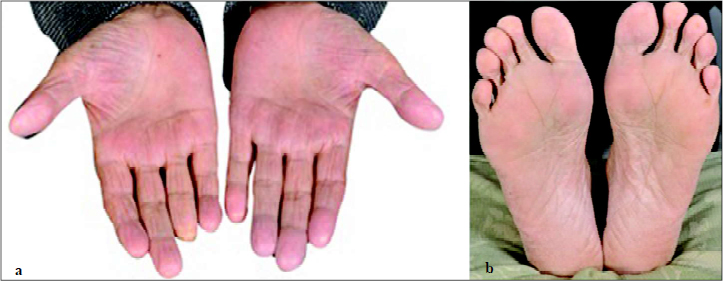Translate this page into:
Adermatoglyphia
Corresponding Author:
Jamal Alruwaili
Department of Medical Laboratory Technology, Faculty of Applied Medical Sciences, Northern Border University, Arar
Saudi Arabia
malkh1195@hotmail.com
| How to cite this article: Alruwaili J, Hai A. Adermatoglyphia. Natl Med J India 2019;32:253 |
A 60-year-old man from Saudi Arabia had no epidermal ridges on his hands and feet [Figure - 1]a and [Figure - 1]b. He had no history of any drug use, long-term medication or environmental exposure. Through Sanger sequencing, c.378+1G>T transversion in the skin-specific isoform of the SMARCAD1 gene was detected in the patient. This variant has previously been reported in another family. Our report confirms the role of SMARCAD1 in the formation of epidermal ridges. It is possible that the skin-specific isoform of SMARCAD1 targets genes that are involved in the development of dermatoglyph and sweat glands. The results indicate the monogenic nature of skin-related disorders, which may be useful in further investigations.
 |
| Figure 1: Absence of epidermal ridges on the patient's (a) both hands; and (b) soles of the feet |
Adermatoglyphia (ADERM; OMIM136000) is a rare condition manifest by the absence of ridges on fingers and toes, as well as on the palms and soles. It is marked by entirely flat digit pads and reduced number of sweat glands. Since the fingerprint-based identification of cases with ADERM is difficult, this condition is also known as ‘immigration delay disease’. In syndromic cases, ADERM is associated with other features generally affecting the skin. In familial cases, it segregates in an autosomal dominant fashion and mutations in the SMARCAD1 gene have been implicated in Basan syndrome (OMIM129200), a form of ADERM associated with congenital facial milia, acral blistering, digital contractures and nail abnormalities.
Conflicts of interest. None declared
Fulltext Views
4,107
PDF downloads
2,687




